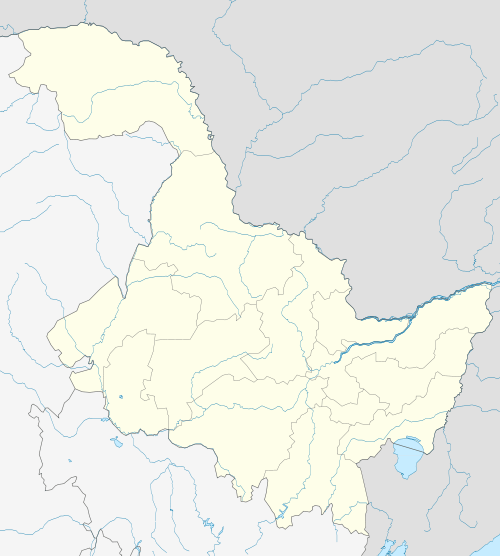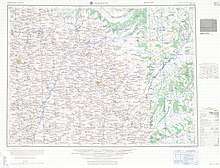Hailun
Hailun (simplified Chinese: 海伦; traditional Chinese: 海倫; pinyin: Hǎilún) is a city in west-central Heilongjiang province, People's Republic of China. Administratively, it is a county-level city of Suihua City.
Hailun 海伦市 Hai-lun | |
|---|---|
 Hailun Location in Heilongjiang | |
| Coordinates: 47°28′N 126°58′E | |
| Country | People's Republic of China |
| Province | Heilongjiang |
| Prefecture-level city | Suihua |
| Municipal seat | Hailun Town (海伦镇) |
| Area | |
| • Total | 4,667 km2 (1,802 sq mi) |
| Elevation | 239 m (784 ft) |
| Population (2002) | |
| • Total | 810,000 |
| • Density | 170/km2 (450/sq mi) |
| Time zone | UTC+8 (China Standard) |
| Postal code | 152300 |
| Area code(s) | 0455 |
| Climate | Dwb |
History
Before Qing Dynasty
Hailun is one of the counties with early governance in Heilongjiang Province. Since ancient times, the ancestors of the Chinese nation have worked and lived on this land. During the Qin, Han, Tang, Liao, Jin, Yuan, and Ming dynasties, ethnic minorities lived, reproduced, and worked. The city of Hailun is named after the Hailun River. The name Hailun is a variation of the manchu language word that sounds like "kailing", which means "otter" . It is named because the otter is abundant in the Hailun River. It was named hailun after the establishment of the city. The area around Hailun was the Qing court. Hai lun was successively ruled in Hulan City Shouwei, by the Hulan Deputy Capital.
Qing Dynasty
In 1885 (the eleventh year of Guangxu in Qing Dynasty), after the Suihua Office was established, it was under the jurisdiction of the Suihua Office. In the twenty-fourth year of Guangxu (1898), Tongkun Deputy Metropolitan Government was established, and the territory of Hailun County was under its jurisdiction; in the thirty-two years of Guangxu (1906), Tongken Deputy Metropolitan Government was cut and Tongken Association was appointed; In the first year of Xuantong (1909), Helen Zhili Office was changed to Hailun Mansion;
Republic of China
In 1912 (the first year of the Republic of China), Hailun Prefecture was changed to Hailun County; in the 6th year of the Republic of China (1917), Wangkui was established in January. Since then, Hailun and Wangkui divided and restored Hailun County; in 1932, after the Japanese invasion, Hailun County belongs to the pseudo-binjiang province. On August 15, 1945, manchukuo was destroyed and the people of the county were liberated. Under the leadership of the Communist Party of China, the People's Government was established in November 1945. Until the founding of the People's Republic of China in 1949, Hailun County had been under the jurisdiction of Heinen and Heilongjiang successively.
After the founding of new China
After the founding of the People's Republic of China on October 1, 1949, Hailun County has always been under the jurisdiction of Heilongjiang Province. In 1985, there were 7 towns and 10 streets in the county; 22 townships and 360 villages. On December 23, 1989, the State Council approved the cancellation of Hailun County and the establishment of Hailun City (county level). The administrative area of Hailun County was regarded as the administrative area of Hailun City, and it was still under Suihua District. On January 11, 1990, the county was officially withdrawn from the city. In August 2016, Changfa Township, Yongfu Township, and Xiangrong Township of Hailun City withdrew their towns and established towns. The original administrative area, original affiliation, and government location remain unchanged.
Referenced from
https://www.newton.com.tw/wiki/海倫/2409 Which is a chinese source that i found in baidu.
Please edit this with the right reference form.
Geography and climate

Hailun is located on the Songnen Plain, with the Lesser Khingan mountain range to the west. Its administrative area ranges in latitude from 46° 58' to 47° 52' N, and in longitude from 126° 14' to 127° 45' E.
Hailun has a humid continental climate (Köppen: Dwb), with long, bitterly cold, but dry winters, and humid, very warm summers. The monthly daily mean temperature in January, the coldest month, is −21.1 °C (−6.0 °F), and July, the warmest month, averages 21.9 °C (71.4 °F), with an average annual temperature +2.48 °C (36.5 °F). Close to two-thirds of the annual precipitation falls from June to August. With monthly percent possible sunshine ranging from 53% in July to 71% in February, the city receives 2,680 hours of bright sunshine annually.
| Climate data for Hailun (1981−2010 normals) | |||||||||||||
|---|---|---|---|---|---|---|---|---|---|---|---|---|---|
| Month | Jan | Feb | Mar | Apr | May | Jun | Jul | Aug | Sep | Oct | Nov | Dec | Year |
| Record high °C (°F) | −0.5 (31.1) |
6.0 (42.8) |
19.1 (66.4) |
28.3 (82.9) |
33.0 (91.4) |
38.0 (100.4) |
36.6 (97.9) |
35.4 (95.7) |
32.5 (90.5) |
24.7 (76.5) |
13.5 (56.3) |
3.4 (38.1) |
38.0 (100.4) |
| Average high °C (°F) | −16.1 (3.0) |
−10.0 (14.0) |
0.0 (32.0) |
11.7 (53.1) |
20.0 (68.0) |
25.3 (77.5) |
26.6 (79.9) |
25.1 (77.2) |
19.5 (67.1) |
9.9 (49.8) |
−3.2 (26.2) |
−13.4 (7.9) |
8.0 (46.3) |
| Daily mean °C (°F) | −21.1 (−6.0) |
−15.8 (3.6) |
−5.6 (21.9) |
5.6 (42.1) |
13.6 (56.5) |
19.6 (67.3) |
21.9 (71.4) |
20.1 (68.2) |
13.5 (56.3) |
4.3 (39.7) |
−8.2 (17.2) |
−18.1 (−0.6) |
2.5 (36.5) |
| Average low °C (°F) | −25.6 (−14.1) |
−21.2 (−6.2) |
−11.1 (12.0) |
−0.2 (31.6) |
7.1 (44.8) |
13.9 (57.0) |
17.3 (63.1) |
15.5 (59.9) |
8.0 (46.4) |
−0.5 (31.1) |
−12.6 (9.3) |
−22.4 (−8.3) |
−2.6 (27.2) |
| Record low °C (°F) | −40.3 (−40.5) |
−36.6 (−33.9) |
−32.0 (−25.6) |
−16.0 (3.2) |
−7.9 (17.8) |
2.4 (36.3) |
7.1 (44.8) |
3.1 (37.6) |
−5.0 (23.0) |
−19.1 (−2.4) |
−31.1 (−24.0) |
−37.2 (−35.0) |
−40.3 (−40.5) |
| Average precipitation mm (inches) | 3.3 (0.13) |
3.0 (0.12) |
9.3 (0.37) |
24.8 (0.98) |
45.3 (1.78) |
95.8 (3.77) |
137.9 (5.43) |
134.1 (5.28) |
59.0 (2.32) |
23.8 (0.94) |
7.3 (0.29) |
6.0 (0.24) |
549.6 (21.65) |
| Average precipitation days (≥ 0.1 mm) | 4.5 | 4.0 | 4.7 | 7.2 | 10.5 | 14.6 | 14.7 | 13.5 | 11.1 | 7.2 | 5.9 | 6.3 | 104.2 |
| Average relative humidity (%) | 75 | 70 | 59 | 54 | 53 | 65 | 78 | 79 | 70 | 63 | 67 | 74 | 67 |
| Mean monthly sunshine hours | 181.6 | 204.8 | 249.8 | 236.6 | 270.8 | 265.6 | 257.2 | 251.9 | 227.7 | 208.4 | 172.8 | 152.9 | 2,680.1 |
| Percent possible sunshine | 66 | 71 | 68 | 58 | 58 | 56 | 53 | 57 | 61 | 62 | 62 | 58 | 60 |
| Source: China Meteorological Administration (precipitation days and sunshine 1971–2000)[1][2] | |||||||||||||
References
- 中国气象数据网 - WeatherBk Data (in Chinese). China Meteorological Administration. Retrieved 2020-04-15.
- 中国地面国际交换站气候标准值月值数据集(1971-2000年). China Meteorological Administration. Archived from the original on 2013-09-21. Retrieved 2010-05-25.